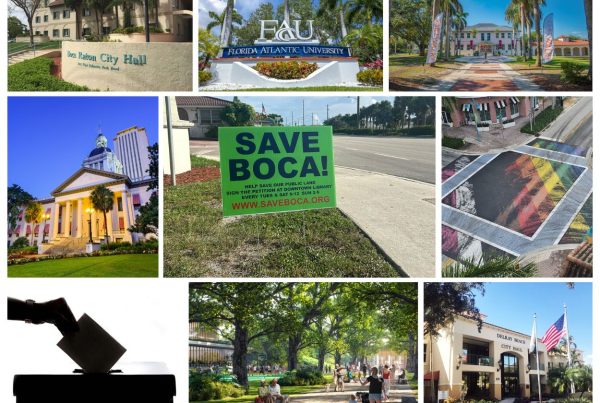Boca Beautiful skimps on the facts
Boca Beautiful has taken out a second deceptive ad to rail against downtown development.
Two months ago, the group ran an ad in the Sun-Sentinel and headlined it “Breaking the Law in Boca.” The ad stated that the city had “condoned cheating” by developers on how much open space they provided at their projects. Boca Beautiful President John Gore, however, could offer no evidence of this “cheating.”
The new ad, which ran Tuesday, is headlined “Construction = Destruction.” It states that “the Boca Raton we know and love is being ruined by a blight of new construction and traffic.”
As the saying goes, however, you’re entitled to your own opinion, but not your own facts. The ad claims that “what’s being built now is less than half of what is planned for the ‘new’ downtown. LESS THAN HALF!”
The clear implication is that more than 50 percent of the downtown remains up for development. That is false. According to the city’s report this month on Ordinance 4035—the order that governs downtown development—only 17.4 percent downtown space remains up for approval. The rest has been used or allocated to projects that have been approved but haven’t been built. Examples: Phases 2 and 3 of Via Mizner.
In 1988, Boca Raton set the limit for downtown development at 8 million square feet. That number was based on all projects being office space, which has the highest impact on traffic. The percentage remaining can vary, depending on what developers propose. Residential projects generate less traffic, and thus may count less toward the 8 million square foot cap.
Gore told me that he “stands by what I said” in the ad. The problem is that he bases his calculation on an assumption: The city council will “go above” 8 million square feet because the developers will want to build more. His statement about “what is planned” for downtown refers to “what the developers are planning.” He bases that assumption on meetings with Royal Palm Place’s James Batmasian and others.
Mayor Susan Haynie said, “I do not agree with Mr. Gore’s assumption.” Batmasian, she said, did recently submit plans to convert some Royal Palm Place retail space to residential, but city staff sent back the plans.
Though some conversion may occur, Haynie said, much of that remaining square footage probably will go to the proposed Mizner 200—which would replace Mizner on the Green—the Winn-Dixie plaza along Camino Real and to Boca Raton itself. City Hall is in the downtown, and the city is assessing plans for all its properties. That new report confirms that those three areas have the most remaining available downtown square footage.
The ad questions whether Boca Raton will have the road capacity to adequately handle a built-out downtown. That’s a legitimate question. It’s also one the city is studying, though a more developed downtown obviously brings more traffic. It was easy to get around downtown Boca in 1980. No one, though, could credibly argue that Boca was healthier in 1980.
In truth, most criticism about downtown is coming from a comparatively small group of residents. Most live in the Golden Triangle north and west of Palmetto Park Road and Northeast Fifth Avenue, the intersection for which the city and a consultant are devising changes to improve the flow of traffic. Other critics live across the bridge on the barrier island.
Their chief grievances are local: approval of Palmetto Promenade, the three-block mixed-use project just west of the intersection, and Chabad East Boca, near the beach. They also oppose using the Wildflower property for a restaurant, and try to perpetuate the myth that the council in 2009 paid $7.5 million for the site to create a 2.2-acre park.
All these grievances, plus city politics, will bring the April 11 Community Redevelopment Agency meeting to a rolling boil. City staffers are set to present their review of how the city has applied those open space guidelines since Boca adopted Ordinance 4035 nearly three decades ago.
If the review absolves the city, the regular council critics likely won’t accept the finding. Some may call for an outside review, which would waste money and essentially tell the staff that the council doesn’t trust them.
But that’s where Boca is, even if most residents aren’t following the politics. BocaWatch Publisher Al Zucaro, who I hear is reaching out to homeowner associations as he contemplates challenging Haynie next year, already has found the council guilty of ignoring Ordinance 4035’s open space requirements. A recent letter from the Riviera Civic Association, which opposed Chabad East Boca, claimed that the city has “ignored” the ordinance since 2003. Evidence? They don’t need no stinking evidence.
At a recent meeting, one of the regular critics accused the council of trying to “bend us to your will,” the “us” being the public. He claimed that the council forces residents to sue. State and federal lawsuits are challenging the Chabad East Boca approval. He proposed a new system under which citizen groups would review all development proposals. Naturally, the groups he suggested for participation were Boca Beautiful and Boca Watch.
As the speaker surely knows, there is citizen review already: the Community Appearance Board, the Planning and Zoning Board and the council itself. And as the speaker berated the council for “citizen exclusion,” Haynie gently reminded him that the council had allowed him double the usual—generous—five minutes during “public requests.”
In the 2014 and 2015 elections, the outspoken anti-development candidates lost. In addition to the mayor’s seat, two council positions will be on the ballot next year. The outsider campaign for the 2017 election has begun. Like the Donald Trump campaign, it’s long on emotion and hyperbole and short on facts.
MIA Jacquet
Like Boca Raton, Delray Beach had no elected positions on the 2016 ballot. The city commission, however, does hold an organizational meeting every year at this time. That happened Tuesday night.
At the meeting, the commission named Al Jacquet to succeed Shelly Petrolia as vice mayor and made Jordana Jajura deputy vice mayor. Since the vice mayor runs the meeting if the mayor can’t be there, Mayor Cary Glickstein will want to continue his excellent attendance record.
Jacquet has missed, or been late for several key meetings in the last two years. In March 2014, during his last stint as vice mayor, Jacquet presided over a meeting at which the commission approved a bailout for the developers of Auburn Trace. Delray’s chief financial officer and then-city attorney blasted the deal as very unfavorable for the city. The vote happened with Glickstein and Petrolia out of town.
Fortunately, a vote two weeks later—with Glickstein and Petrolia present—rescinded the deal. Jacquet was absent. If Jacquet had prevailed, Delray Beach could not have concluded this year the deal to sell Auburn Trace, make the city nearly $1 million and free up another $4 million for affordable housing initiatives.
Stay healthy, Mayor Glickstein.
Boca to choose deputy mayor
The Boca Raton City Council will hold its own organizational meeting tonight. Like the Delray commission, the council will choose a deputy mayor.
Unlike the Delray commission, however, the Boca council also acts as the community redevelopment agency. The council designates one member as the chairman, who runs the CRA meetings. That has been Scott Singer.
Nothing prevents the council from naming the mayor to also run the CRA meetings, but Haynie said sentiment has been to divide the two roles. The choice takes on added meaning this year, however, because the new chairman will get to run that open space meeting in 12 days. Don’t send the winner any congratulations.
And the Arts Garage vote
At its meeting Tuesday night, the Delray Beach City Commission will vote whether to extend until Sept. 16 the lease of the city space in Pineapple Grove to Creative City Collaborative, the parent organization of Arts Garage. The group’s three-year lease expired March 16.
The extension is designed to allow the city and the collaborative to work out a new lease. The city commission wants Arts Garage to make management changes and improve communication with the city before approval of a new lease.
About the Author
Randy Schultz was born in Hartford, Conn., and graduated from the University of Tennessee in 1974. He has lived in South Florida since then, and in Boca Raton since 1985. Schultz spent nearly 40 years in daily journalism at the Miami Herald and Palm Beach Post, most recently as editorial page editor at the Post. His wife, Shelley, is director of The Learning Network at Pine Crest School. His son, an attorney, and daughter-in-law and three grandchildren also live in Boca Raton. His daughter is a veterinarian who lives in Baltimore.








